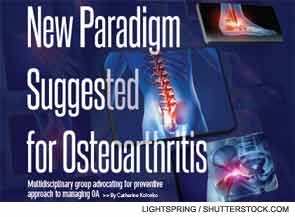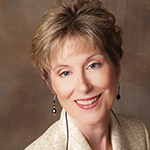
A group of professionals who study and treat osteoarthritis want to adopt a new treatment paradigm and change the pervasive perception that the disease is an inevitable consequence of old age.
Just the mention of diabetes and heart disease calls to mind frequent public discussion and media coverage about risk factors, lifestyle preventions, and healthcare models; meanwhile, osteoarthritis (OA) seldom gets noticed, say members of the Chronic Osteoarthritis Management Initiative (COAMI). The work group met in 2012 to assess current practice in OA management.
Recent developments in understanding the pathology and management of OA should be reflected in the way we treat and manage the disease, says Maura Iversen, PT, DPT, SD, MPH, professor and chair of the department of physical therapy at Northeastern University in Boston, associate editor of The Rheumatologist, and a work group participant.
“The COAMI group is striving to implement a new model of care much like the diabetes model where you walk into the doctor’s office and are screened for the disease, hopefully to identify who is at risk before they develop symptoms or help those with early disease,” says Dr. Iversen.
If people at risk for developing OA could be identified in a similar way, convincing them to increase physical activity and drop excess pounds could mean preventing or delaying progression of the disease, says Dr. Iversen.
Just exactly why OA lacks the media status of other chronic conditions is debatable, but one theory is that patients don’t die from it like they do from AIDS or heart attacks. Still, the disease impact is far reaching.
Osteoarthritis affects an estimated 27 million Americans, more than 10% of the U.S. adult population. Though it is the most common form of arthritis and a leading cause of disability in the United States, OA interventions tend to start later in the disease process than those of other chronic conditions, according to the COAMI report, which summarizes a call to action for a new approach to the disease.1
The global initiative, a spinoff from the United States Bone and Joint Initiative, brought together medical professionals from various countries and included rheumatologists, osteopathic and primary care physicians, orthopedic nurses and surgeons, and specialists in rehabilitation, sports medicine, physical therapy, and athletic training.
The shift in approach to an international campaign is designed to enable people across the globe to get the word out about OA, particularly how important it is for adults to be screened for it; this is a major transition in practice management, says Dr. Iversen.
The COAMI report proposes a shift in the treatment paradigm from the current episodic and reactive approach to one that is similar to treatment for diabetes and other chronic diseases.
The group focused their efforts on the following seven priorities:
- Issue a call to action for healthcare professionals, policy makers, and the public;
- Hold a conference to build agreement across disciplines;
- Communicate with other partners beyond their group;
- Explore standard screening tools;
- Promote patient engagement;
- Support existing advocacy; and
- Develop and support an osteoarthritis-specific research agenda.
Changing the Paradigm Begins with Awareness
Existing advocacy for OA needs an update, agrees Roland Chang, MD, professor of preventive medicine, senior associate dean for public health, and director of the Institute for Public Health and Medicine at Northwestern University Feinberg School of Medicine in Chicago. He uses the analogy of preventive cardiology during its early years.
“I would say that rheumatology is where cardiology was in the 1950s,” says Dr. Chang. “Everybody thought at that time that heart attacks were an inevitable consequence of aging and we really couldn’t prevent them.”
Dr. Chang notes that following years of cardiology research, efforts switched from averting a second heart attack to avoiding even the first one through prevention measures, lifestyle changes, and better monitoring of people with high risks for heart disease.
With OA, a lack of public knowledge about disease symptoms and treatment options often mirrors that of primary healthcare providers.
The common public perspective used to be that “OA was something your grandmother got,” notes Dr. Iversen. “Now we know that osteoarthritis can be caused by injury, poor biomechanics, and has an inflammatory component. OA may be evident even in young adults who have had a ligament injury.”
A major concern is that OA is not consistently detected and treated. A large portion of the population is either afflicted with the disease or at risk for it. However, most people go to a primary care physician, which means they probably are seldom questioned about joint pain. Furthermore, they may not mention pain on their own, thinking it’s just old-age achiness.
A typical patient who suffers from osteoarthritis might feel pain and stiffness in the joints after prolonged sitting, which may subside with walking or movement. Doctors diagnose the disease through a combination of clinical findings that typically include patient history and symptoms. X-rays are also used, but may not capture early-stage disease, while MRIs provide more conclusive results but are costly.
Challenges exist even among providers who are aware of OA because multidisciplinary treatment approaches are not standardized and there is no consistent set of recommendations and measurements for pain management, according to the COAMI report. This is especially true for patients with moderate symptoms for continuous time periods.
Identifying the best treatment is further complicated because of subgroups in the disease structure, says orthopedic surgeon Nizar Mahomed, MD, professor in the surgery department at the University of Toronto. For example, some types of OA are inflammatory while others are not.
“We need to come together and start to understand and agree upon defining different groupings so that we can have meaningful progress in terms of dealing with this disease,” says Dr. Mahomed. “The reality is if it were simple, it would have been done.”
A better understanding of the disease would allow doctors to tailor treatment more appropriately instead of the current algorithm, which is more or less a shotgun approach of exercise, weight loss, medication, physical therapy, and surgical management, says Dr. Mahomed.
“There are different responder patterns to this disease,” says Dr. Mahomed. “It’s all linked to the fact that we have to understand better what the fundamental disease is so that we can then try to identify better treatment strategies.”
Screening Tools
To enable practitioners to better screen for OA so that they can intervene sooner, providers need basic, standardized tools to gauge patient risk, disability, pain, and loss of function. That requires agreement across disciplines on which screening tools work best. One way to achieve consensus on optimal screening tools is through high-quality, cross-disciplinary research studies, according to Norelee Kennedy, a physical therapist and OA researcher at Ireland’s University of Limerick.
“Notwithstanding that there will always be discussion on the ideal screening tool for any condition, the evidence is clear that there is a strong need for a more coordinated approach to chronic disease and OA management,” notes Kennedy.
The coalition intends to compile information about such tools as validated questionnaires and other methods used to diagnose and assess the disease, says Dr. Iversen. Its next meeting will focus on synthesizing literature to develop a compendium of OA screening tools available to general medical professionals.
Risk Factors
Also in the works is a public relations campaign to raise the profile of OA, better educate the public about risk factors, and lend support to existing advocacy groups, says Dr. Iversen.
Among the top risk factors for developing osteoarthritis—obesity, aging, and genetics—excess weight on the bones is the easiest to modify yet it continues to plague a large portion of the population. Other risk factors include family history, major injury or surgery to the knee or hip, and malalignment of the joints. Joint malalignment, often seen as bowleggedness, can make matters much worst for an overweight person, notes Dr. Iversen.
We would like to be able to look at preventive techniques so that people don’t get to that stage where they are seeking total joint replacement.
—Maura Iversen, PT, DPT, SD, MPH
Fix It or Prevent It
Getting people to think about things as basic as maintaining healthy body weight throughout life could have a major impact on a significant portion of people who develop OA, says Dr. Chang.
“If we were able to wipe out obesity, some epidemiologists think that we might be able to prevent about one-third of all the knee osteoarthritis that we have in the world,” he says.
It may sound simple but it won’t be easy, says David T. Felson, MD, professor of medicine and epidemiology at Boston University School of Medicine, and a clinical researcher who studies OA risk factors and prevention opportunities. Convincing people to lose weight and increase physical activity poses a huge challenge to medical professionals and advocates alike.
“Those aren’t popular treatments that people willingly adopt and adhere to,” says Dr. Felson. “Those are very difficult things for people to do. There needs to be some concerted effort on the part of practitioners in the learning process for patients to sort of come to grips with the fact that they need to do those things.”
The message of prevention is often a hard sell to young customers. Just try telling someone in their 30s to modify his or her lifestyle or face the possibility of an arthritic knee 10 to 20 years down the road, says Dr. Mahomed.
“People are not going to be open to those sorts of things unless there’s a much deeper understanding of the implications of it,” says Dr. Mahomed.
Another possible obstacle is that the success and advances in joint replacement surgery may create the unwanted impression among the general population that there’s no need for prevention, says Dr. Iversen.
“We would like to be able to look at preventive techniques so that people don’t get to that stage where they are seeking total joint replacement,” says Dr. Iversen.
How we talk about disease treatment also makes a difference in how it is perceived, points out Ewa Roos, PhD, PT, professor and head of the Musculoskeletal Function and Physiotherapy research unit at the University of Southern Denmark’s Institute of Sports Science and Clinical Biomechanics. Regarding OA as a disease where surgery is a solution means education, exercise, and weight loss are often considered “conservative treatment,” making it less attractive to just about everyone, says Dr. Roos.
“This terminology also signals education, exercise, and weight loss as being ‘old-fashioned,’ ” says Dr. Roos, who prefers the term “preventive.”
To avoid more invasive types of interventions such as surgery, knee and hip pain should be treated more like back pain—at the first sign of symptoms—instead of waiting for OA to develop, says Dr. Roos.
“What we are proposing is that you should act a lot earlier. You should act on the first symptoms to be able to prevent progression of symptoms and of disease,” says Dr. Roos.
If we were able to wipe out obesity, some epidemiologists think that we might be able to prevent about one-third of all the knee osteoarthritis that we have in the world.
—Roland Chang, MD
Healthcare Costs
The costs to treat OA are high and expected to climb. Managing the condition proactively with an eye toward prevention should help to lessen the individual and societal financial burden, says Kennedy.
“This is particularly important in the context of an aging society where, in the absence of a proactive approach to OA prevention and early management, increased incidence of OA will be a certainty,” says Kennedy.
“If we could make a significant difference in understanding and treating OA, there would be significant financial impact and cost savings to the health care system” and the tens of millions of people who suffer from it, says Dr. Mahomed.
Catherine Kolonko is a medical writer based in California.



